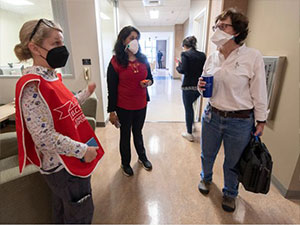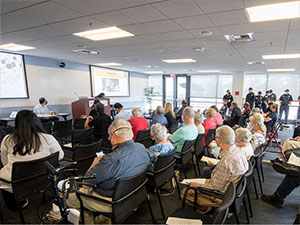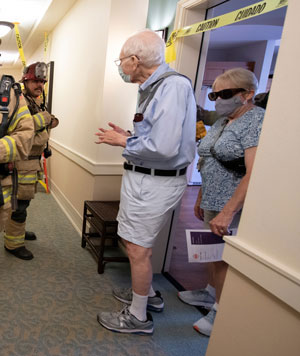UCI develops first technology to aid disaster response for older adults

Irvine, Calif. — UC Irvine researchers have developed and successfully tested a new data exchange system to provide first responders with real-time, critical health information about senior care center residents, who are at greatest risk during disasters.
Called CareDEX (Enabling Disaster Resilience in Aging Communities via a secure Data Exchange), the system enabled first responders to locate, rescue and treat elderly residents in a successful test during this year’s Great California Shakeout earthquake drill on Oct. 20.
The smart-platform technology is the result of a multiyear, multidisciplinary collaboration between UCI geriatric medicine and computer science experts, a nationwide provider of senior care services and federal and local first responders.
“Older adults are our most vulnerable population during natural disasters,” said UCI Health geriatrician Dr. Lisa M. Gibbs, a key partner in the project’s development.
“Many of them have difficulty evacuating because of medical problems — such as mobility issues, vision impairment or dementia — and the period after evacuation is critical for those who require oxygen, dialysis, and medications,” added Gibbs, the Ronald Reagan Endowed Chair and chief of the Division of Geriatric Medicine & Gerontology at the UCI School of Medicine.
Older adults fare worst
“Over the years, our team has worked with disaster response awareness and one of the things that we realized, especially with the COVID-19 pandemic, is that when you look at disasters of any kind, a disproportionate number of older adults suffer fatalities and injuries,” said Nalini Venkatasubramanian, PhD, the project’s principal investigator and professor of computer science at the Donald Bren School of Information and Computer Sciences.
Consider these statistics:
- In 2020, over 80% of COVID-19 deaths were people age 65 or older and 47% of them resided in elder care facilities.
- Of the 86 confirmed deaths in the 2018 wildfire that destroyed the Northern California town of Paradise, 77% were age 65 or older.
- In 2005, 75% of those who died in Hurricane Katrina were age 60 or older.
- Of the more than 6,000 lives lost to the 1995 earthquake in Kobe Japan, 50% of the immediate casualties and 90% of subsequent deaths were people age 60 and older.
“With our growing senior population and the increasing frequency and severity of natural disasters — including wildfires, earthquakes, hurricanes and even COVID — geriatric mortality is sure to escalate in the years to come,” said Gibbs. “The time to plan and build natural disaster resilience is now.”
How it works
The information-sharing platform works by facilitating the rapid assimilation and exchange of information. It can be readily adapted for senior housing facilities and age-friendly communities where large numbers of older U.S. adults live.
“The technology can be used on a regular basis but it also can morph to provide situational awareness during a disaster,” said Venkatasubramanian. “It empowers organizations to gather, store and exchange information with response agencies to help protect and care for the elderly during natural disasters."
The platform provides authorized first responders with seamless access to information about living facilities (e.g., floor plans, operational status, number of occupants) and important data about the residents (e.g., health conditions such as the need for dialysis, oxygen, even personal objects to reduce anxiety).
This level of detail helps first responders improve response times and outcomes, especially by being able to immediately identify who needs specialized triage and critical care. During the recent test, the platform’s data combined with sensors worn by residents of a senior care facility enabled first responders to identify and rescue an additional eight people who otherwise would have been missed.
Calibrating the response
Often the initial disaster is not what leads to death.
“Fatalities are frequently tied to what happens afterwards — the lack of timely care for individuals who need dialysis or medication or the lack of power for oxygen-dependent patients,” said Venkatasubramanian.
“You can’t just send people who need extra care into an arena or convention center and expect them to do well,” added Gibbs. “Additional factors need to be considered to get them the right care and to the right facilities.”
For example:
- How do you evacuate people quickly who need specialized equipment to keep them alive?
- How do you make sure older people have the resources they need to maintain their health after being evacuated?
- How do you help someone with dementia who may not understand that there is an emergency? Does the person have specific triggers that would cause them to become agitated or non-responsive?
- If their residence is uninhabitable after the disaster, where do they go to live?
Promising results
“The pilot program showed us there is real potential for this system to make a substantial impact in future disaster response efforts,” said team member Julie Rousseau, PhD, CNM, RN, a senior project scientist in geriatrics and nursing at UCI School of Medicine.
“Our ability to perform the drill in real time at a senior housing facility was especially unique and that drill was shown nationwide over Zoom.”
The CareDEX platform was developed with a $1 million Civic Innovation Challenge grant from the National Science Foundation in partnership with the U.S. departments of Energy and Homeland Security. Gibbs said the next step is to determine where CareDEX could best fit into the California and U.S. natural disaster response systems.
“Whether earthquakes, flood, fires or other disasters, we have a mandate to prepare and reduce the injuries, loss of life and trauma that impacts the lives of our older citizens,” said Gibbs.
Learn more about the data platform ›
UCI Health is the clinical enterprise of the University of California, Irvine, and the only academic health system in Orange County. Patients can access UCI Health at primary and specialty care offices across Orange County and at its main campus, UCI Medical Center in Orange, Calif. The 459-bed, acute care hospital, listed among America’s Best Hospitals by U.S. News & World Report for 22 consecutive years, provides tertiary and quaternary care, ambulatory and specialty medical clinics, behavioral health and rehabilitation services. UCI Medical Center is home to Orange County’s only National Cancer Institute-designated comprehensive cancer center, high-risk perinatal/neonatal program and American College of Surgeons-verified Level I adult and Level II pediatric trauma center and regional burn center. UCI Health serves a region of nearly 4 million people in Orange County, western Riverside County and southeast Los Angeles County. Follow us on Facebook, Instagram, LinkedIn and Twitter.






